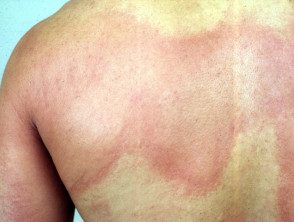What is it urticaria?
Urticaria is characterized by cure (urticaria) or angioedema (swellings, at 10%) or both (at 40%). There are several types of urticaria. The name urticaria is derived from the common European nettle 'Urtica dioica'.
A bump (or bump) is a superficial swelling of pale or skin color, usually surrounded by erythema (redness) that lasts from a few minutes to 24 hours. Usually itchy, may have a burning sensation.
Angioedema is a deeper swelling inside the skin or mucous membranes and can be skin colored or red. It resolves in 72 hours. Angioedema can cause itching or pain but is often asymptomatic.
Urticaria and angioedema.


Image provided by Dr. Shahbaz A Janjua

See more hives images.
What is it acute urticaria?
Acute urticaria is urticaria, with or without angioedema, that is present for less than 6 weeks. It often goes away in a matter of hours or days.
Who gets acute urticaria?
One in five children or adults has an episode of acute urticaria during their lifetime. It is more common in atopic individuals. It affects all races and both sexes.
What causes acute urticaria?
The scars are due to the release of chemical mediators from the tissue. mast cells and circulating basophils. These chemical mediators include histamine, plateletactivation factor and cytokines. Mediators activate the sensory nerves and cause dilation of blood vessels and fluid leakage into the surrounding tissues. The release of bradykinin causes angioedema.
Several hypotheses have been proposed to explain urticaria. The immune, arachidonic acid and coagulation systems are involved, and genetic mutations are under investigation
Serum The disease and disease-like serum reactions are due to the immune complex. statement in affected tissues.
Acute urticaria can be induced by the following factors, but the cause is not always identified.
- Acute viral infection - an upper respiratory infection, viral hepatitisinfectious mononucleosis
- Acute bacterial infection - a dental abscesssinusitis, mycoplasma
Food allergy (IgE mediated) - usually milk, egg, peanuts, shellfish
Drug-induced urticaria (IgE-mediated): often an antibiotic
Drug-induced urticaria due to pseudoallergy - aspirin, non-selective non-steroidalinflammatory drugs, opiates, radio contrast media; these cause hives without immune activation
- Vaccination
- Bee or wasp stings
- Extended next reaction located contact urticaria - rubber latex
Severe allergic urticaria can lead to anaphylactic shock (bronchospasm, collapse).
A single episode or recurrent Episodes of angioedema without urticaria may be due to angiotensin conversion enzyme (ACE) inhibitor drug.
What are the clinical characteristics of acute urticaria?
Urticaria Scars can be a few millimeters or several centimeters in diameter, white or red in color, with or without a red flare. Each cure can last a few minutes or several hours and can change shape. The marks can be round, or form rings, a map-like pattern, targettoid giant lesions or patches.
Acute urticaria can affect any part of the body and tends to spread widely.
Angioedema is located more frequently. It commonly affects the face (especially the eyelids and perioral sites), hands, feet and genitals. May involve tongue, uvula, soft palate, larynx.
Serum sickness due to blood transfusion and serum sickness-like reactions due to certain medications cause acute urticaria that leaves bruises, fever, swollen lymph nodes, joint pain and swelling.
How is acute urticaria diagnosed?
Acute urticaria is diagnosed in people with a short history of illness lasting less than 24 hours, with or without angioedema. A complete physical examination should be performed to search for the underlying causes.
Radioallergosorbent skin tests (RAST) or CAP fluoroimmunoassay may be ordered if a food or drug allergy is suspected in acute urticaria.
Biopsy Hives can be nonspecific and difficult to interpret. the pathology shows edema at dermis and dilated blood vessels, with a mixed inflammatory variable infiltrate. Damage to the vessel wall indicates hives vasculitis.
What is the treatment for acute urticaria?
The main treatment for acute urticaria in adults and children is with a second-generation oral antihistamine chosen from the list below. If the standard dose (eg, 10 mg of cetirizine) is not effective, the dose may be increased four times (eg, 40 mg of cetirizine daily). They are best taken on an ongoing basis rather than on demand. They stop when the acute urticaria has subsided. There is not believed to be any benefit in adding a second antihistamine.
- Cetirizine
- Loratadine
- Fexofenadine
- Desloratadine
- Levocetirizine
- Rupatadine
- Bilastine
Terfenadine and astemizole should not be used as they are cardiotoxic in combination with ketoconazole or erythromycin. They are no longer available in New Zealand.
Although systemic it is better to avoid treatment during pregnancy and lactation, there have been no reports that second generation antihistamines cause birth defects. If treatment is required, loratadine and cetirizine are currently preferred.
Conventional first-generation antihistamines like Promethazine or Chlorpheniramine are no longer recommended for urticaria.
Psychotherapy reportedly benefits some patients with chronic urticaria.
Avoid triggers
In addition to antihistamines, the cause of hives should be eliminated if known (for example, food or drug allergies). Avoid relevant type 1 (IgE mediated) Allergens clears hives within 48 hours.
In addition to antihistamines, urticaria triggers should be avoided whenever possible. For example:
- Avoid aspirin, opiates, and non-steroids. anti-inflammatory medications (acetaminophen is generally safe).
- Avoid known allergies that have been confirmed by specific positive IgE / skin prick tests if they have clinical relevance for urticaria.
- Cool the affected area with a fan, cold flannel, an ice pack, or a soothing moisturizer. lotion.
Treatment of acute refractory urticaria
If non-sedating antihistamines are not effective, a 4-5 day course of oral prednisone (prednisolone) may be warranted in severe acute urticaria, particularly if angioedema is present. Systemic steroids do not accelerate resolution of symptoms.
Intramuscular injection of adrenaline (epinephrine) is reserved for life-threatening persons. anaphylaxis or swelling of the throat.

